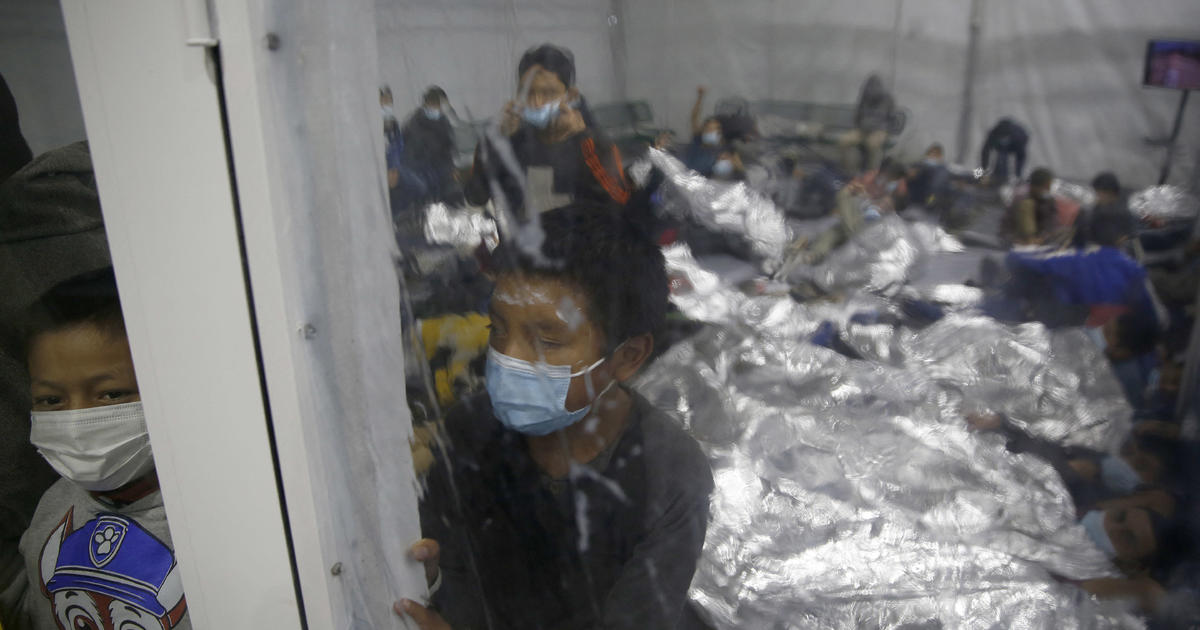US government facilities that keep migrant children along the border with Mexico are “stretched,” concluded an independent monitor after visiting the sites, saying that acute overcrowding created unsafe conditions for thousands of minors in US custody.
In a report presented to the federal court in Los Angeles on Friday, two inspectors appointed by district judge Dolly Gee to monitor conditions faced by children in custody of US immigration detailed “severe overcrowding” at the Customs and Border Protection facilities ( CBP) in southern Texas.
Social detachment was “functionally impossible” within the facility, experts said, calling the level of overcrowding “unsustainable”. In an overcapacity facility, there were not enough caregivers for the 500 migrant children under the age of 12 who were there, the report said.
“The precautions of physical distance to mitigate the spread of COVID-19 were, of necessity, put aside and, even so, the CBP facilities – which are not suitable for minors, in any case – have been extended beyond the limit”, Andrea Sheridan Ordin, the court-appointed independent monitor and Paul Wise, a medical expert, wrote in their report.
DARIO LOPEZ-MILLS / POOL / AFP via Getty Images
Overcrowding was so widespread at CBP’s main facilities for unaccompanied children and families in Donna, Texas, that on certain days there was no space between the mats that migrants used to sleep on, the report said, citing visits that Wise made in March.
“The open spaces designed for walking, reading or playing are also fully occupied by mats,” said the report, referring to the tent complex in Donna. “The showers designed for an occupancy of 1,000 people are occupied all day, with some children reporting that they do not receive showers for days on end.”
As of March 30, there were approximately 3,000 unaccompanied migrant children detained at Donna’s facilities, including 2,500 minors who were in custody of the Border Patrol beyond the legal 72-hour limit. About 500 of the unaccompanied minors were under 12 years of age.
Wise found that the number of caregivers charged with caring for unaccompanied “young age” children in Donna was “profoundly inadequate.” Due to the number of young children, caregivers had to focus on caring only for very young minors and those with special needs.
The independent monitor, named as part of the longstanding case on the Flower Settlement Agreement, which governs the care of migrant children in US custody, noted that water, fruit and snacks for children and families in US custody were “abundant”. Baby formula and diapers were also available.
DARIO LOPEZ-MILLS / POOL / AFP via Getty Images
The report noted that the Border Patrol deployed teams of nurses and medical assistants at its stations and at Donna’s facilities to examine migrant children and families and provide them with the necessary medical services. But the monitor said that an “unsustainable burden” was placed on the medical team working in Donna, who is now being helped by two teams from the United States Public Health Service.
“Carrying out the responsibilities listed above for several thousand migrant children is difficult enough,” said the report. “However, this task is exacerbated by the fact that minors generally come to the establishment in large groups, sometimes reaching 200, thus creating an immediate and sometimes overwhelming demand for health interviews, examinations and medical assessments.”
The report said the conditions, taken together, created an “unsafe environment” for children. CBP did not respond to requests for comment on the findings of the independent monitor.
Friday’s report corroborates the findings about the Donna tent made by lawyers who interviewed children held there and journalists who visited the facility this week. Earlier in the week, Donna’s facility had 1,624% of its pandemic-era capacity, with pods designed to contain 32 migrants under the COVID-19 mitigation protocols, housing more than 600 unaccompanied children.
DARIO LOPEZ-MILLS / POOL / AFP via Getty Images
Overcrowding at border facilities is due to the historical number of unaccompanied children crossing the border between the United States and Mexico and the limited shelter beds for them.
American officials found nearly 19,000 unaccompanied children along the southern border in March, a monthly record. As of Friday morning, there were about 5,400 unaccompanied minors in the short-term Border Patrol detention facilities, which the Biden administration said were not suitable for children.
The Department of Health and Human Services (HHS), which is responsible for the long-term accommodation of unaccompanied children until it can place them with a family member in the United States, has endeavored to remove children from the Border Patrol facilities. .
HHS has identified ten emergency housing locations to accommodate the growing number of children crossing the southern border, including convention centers, oil worker camps, military bases and a Houston church hall that hosted 466 migrant girls on Friday. market. It is also considering additional locations, including the Camp Roberts National Guard post in California.
While the independent monitor said the opening of the emergency facilities represented “a constructive strategy” to get children out of custody of the Border Patrol, he recommended in his report that HHS develop standards for the care of minors in these facilities.
CBS News reported on Thursday that lawyers who inspected two of HHS’s emergency locations expressed concern about limited access to case managers, family calls, outdoor recreation and education that the children staying there reported having.
In a statement, HHS said that case management, education and recreation “are being provided as far as possible in emergency settings”.



